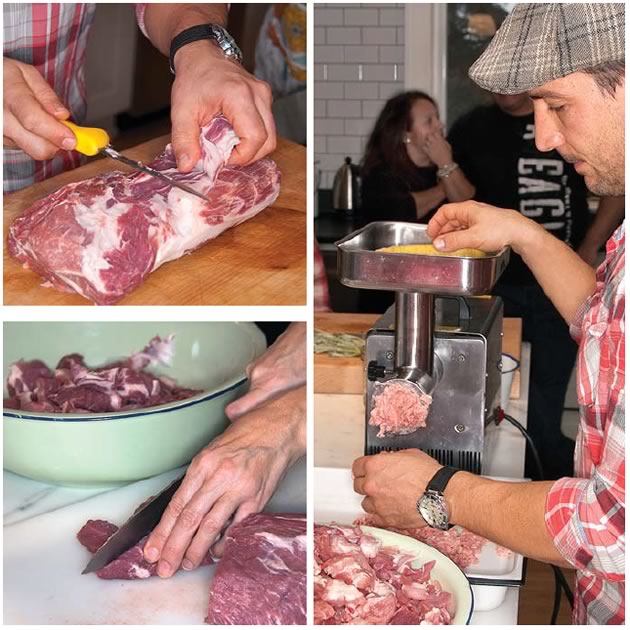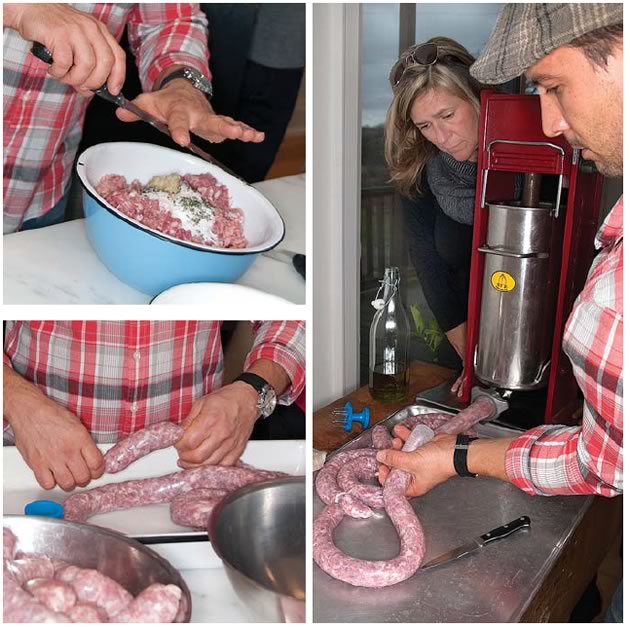A Real Grind
With the right equipment and ingredients, a pinch of perseverance, and a big dollop of humour, you can make your own sausages.
Growing old is not for the faint of heart. Neither, I have discovered, is sausage making. At first glance these two processes may seem unrelated, but aging has, in fact, a lot in common with taking a chunk of firm red meat, adding some seasoning, grinding it up, and then stuffing it into a stretchy casing until it bears no resemblance to its former self.
If you’re lucky, the resulting product, like your aging self, will be a good deal more interesting than the raw material ever was. On the other hand, it can be hell getting there, and what you end up with often isn’t pretty.
Yes, sausages as a metaphor for life. I’ve been thinking about this a lot lately. There’s the mess and the inevitable failures, the frustration and the setbacks, but if you persevere, there’s also satisfaction, pride and, most of all, the joy of having something tasty to throw on the grill for dinner.
For best results you will need a long rainy afternoon, a clean kitchen and, I warn you, special equipment. Most of all you will need patience, a strong stomach and a sense of humour. All, when you think about it, useful tools for growing old.
My adventures in sausage making began last fall when an invitation popped into my inbox to attend Nonna Miriam and Nonno Fabio’s sausage-making workshop at Mad Maple Country Inn and Agriturismo on County Road 124 north of Shelburne.
There’s the mess and the failures, the frustration, the setbacks, but there’s also satisfaction, pride and the joy of having something tasty to throw on the grill for dinner.
“Roll up your sleeves and join the fun in la cucina. Learn how to make your own sausages,” the message read. According to urbandictionary.com, nonna is Italian for “an old woman (generally 50 plus) who is cute and can cook up the most delicious food.” Nonno would be her male counterpart, though maybe not as cute. La cucina, of course, means “the kitchen.”
Although Miriam Streiman, co-owner of Mad Maple, claims to be an Italian nonna in spirit, she is actually a 20-something Jewish girl. About two years ago, she and her husband Neil Epstein left Toronto to open Mad Maple in the home the couple had earlier purchased and renovated. Her friend Fabio Bondi is chef at Toronto’s Local Kitchen and Wine Bar. Both Miriam and Fabio are very young, very cute and can definitely cook up the most delicious food. And though I cannot lay claim to the first two qualities, I like to think I’m not bad in the cucina department. Also, I wanted to make my own sausages before I die.
That afternoon, while I and about 15 other amateurs looked on and sometimes pitched in, Fabio butchered a whole organic Tamworth pork shoulder purchased at Blue Haven Farm near Rockwood. Then he walked us through the life cycle of a pork sausage.
“You could eat this raw as far as I’m concerned. It’s that fresh,” he said, standing before the enormous chunk of meat, cleaver in hand. (Eating raw pork is probably not a good idea, but Fabio’s comment is a tribute to the quality and freshness of the pork.) For the next couple of hours, we chopped and ground and stuffed, the red wine flowed and the aromas of rosemary, sage and garlic filled the air.
One of the participants, Karen Gaudino, was an old hand at this. “My father’s Italian, my mother’s Polish,” she said, “so sausages are in my blood.” Karen likes to throw sausage-making parties at her house. “This is a great thing to do with couples. It gets very funny when the sausages start coming out. The girls get all crazy. The men love it. Everyone gets involved. We drink a lot of beer and then cook the sausages for dinner.”
Sure enough, when the fat noodle of ground pork began oozing out of Fabio’s machine, there were giggles and blushes all around. There is something so “suggestive,” as my mother would say, about sausages, something elemental, even unappetizing about their shape and texture, never mind the mysterious mixture that might be inside them. No wonder they are often the subject of ribald, schoolyard-type humour. And yet, from Moroccan merguez to Mexican chorizo to Scottish haggis, some form of sausage is part of the cuisine of nearly every culture on earth. Even the Japanese make a fish-based log called kamaboko.
Traditionally, sausages were an efficient way of using up and preserving scraps of meat and other animal parts (don’t ask). There is no record of whose idea it was to stuff these assorted ground-up bits and pieces into hog intestines, but there’s little doubt he or she must have abhorred waste even more than Rob (stop-the-gravy-train) Ford.
The fat-to-meat ratio can vary, but remember, when it comes to sausages, fat is a good thing. And after all, some of the best things in life involve risk.
In today’s era of industrial food processing, commercial sausages are often stuffed with what is known as “mechanically recovered meat” or MRM. After meat has been manually removed from a carcass, what remains is ground into a paste known as “white slime” and forced through a sieve under pressure. This purée can contain bone, bone marrow, skin, nerves, blood vessels and … well, once again, you probably shouldn’t ask. Better quality products are also available, but still, there’s no way of knowing what’s actually in there. This is one reason I wanted to make my own sausages in my own cucina, but I also wanted to do this because Fabio and Miriam’s sausages were the best I’ve ever tasted.
The first step was acquiring the necessary equipment. At the Mad Maple workshop, Fabio used an electric grinder and a commercial five-pound vertical sausage stuffer. These can be found on eBay or at restaurant supply shops for about $150 each. Or you can buy an electric meat grinder with sausage tubes for about the same amount.
But both options are a big investment if you’re not a commercial sausage maker. If you’re feeling energetic, you can purchase manual grinders and sausage stuffers for a lot less money. But if you already own a KitchenAid stand mixer – in my opinion, a must for any serious kitchen – you can do what I did: order the meat grinder and sausage stuffing attachments from Amazon for about $70 or so. Do not use a food processor, which will grind the meat too finely.
Next, the ingredients. I bought a four-pound boneless pork shoulder. You will want lots of fat on it, so ask your butcher not to trim it. The fat-to-meat ratio can vary, but remember, when it comes to sausages, fat is a good thing. (Yes, I know, but some of the best things in life involve risk.)
Finding the casings was more challenging. Hog casings aren’t exactly the sort of thing you find on most supermarket shelves. But then Garden Foods in Bolton is not “most” supermarkets. Many of their customers are of Italian descent, and if you’re Italian, sausages are in your blood, right? This independent grocery store has an entire cooler devoted to all things sausage, including casings in containers that sell for $5.99 – enough to make sausages from two pork shoulders. Dave’s Butcher Shop in Orangeville also sells what they call a “string” for $9, enough to make 20 pounds of sausage. Hog casings are packed in salt and should keep indefinitely in the refrigerator, but don’t freeze them, as this makes them prone to tearing.
Finally, one gloomy Saturday afternoon, with all the necessary equipment and ingredients on hand, and Puccini’s Madama Butterfly playing on the radio, I was ready to make sausages. The only thing I hadn’t realized was that sausage making, like many things in life, goes a whole lot better if there are two of you. Fortunately, my worthy assistant, who was reading in the next room, was happy to lend a hand once I had prepped and set up.
First, I cut the pork shoulder into ¾-inch chunks and mixed the meat and seasonings (garlic, rosemary, sage, chilies, nutmeg and salt) in a large bowl. You can use whatever herbs and spices you like, but don’t leave out the salt. Fabio recommended 50 grams of kosher salt for every five pounds of meat, though I found this a little too salty. Start with less; you can always add more later. Next, I put the seasoned meat, as well as the KitchenAid grinding attachment, in the refrigerator for an hour or so. Everything should be really cold before you start so the pork fat doesn’t melt as you work with it, which would produce a dry sausage.
Now for the gross part. But like so many gross things, this was also the most fun. It was time to rinse the sausage casings, which had been soaking in warm water and lemon juice since first thing that morning. I opened the end of each length of casing and held it under the kitchen tap to let a stream of water run through it. As I did this, the casing bulged and bubbled in the most disconcerting, yet somehow charming manner. All the little veins became visible, reminding me in no uncertain terms that these were once living intestines.
Many people are put off by this, but don’t be squeamish. Remember, life can be messy. Besides, I have assurances the casings are thoroughly cleaned in state-of-the-art facilities as sterile as operating rooms. So banish your qualms.
There is something so “suggestive” about sausages, something elemental … No wonder they are often the subject of ribald, schoolyard-type humour.
Once the casings were thoroughly rinsed, I set them aside and assembled the grinder, using the coarse cutting blade. I placed some ice cubes in a large bowl and fit a smaller bowl inside that to catch the meat. Turning on the machine, I began feeding the pork into the hopper, pushing it down until all the meat and spices were ground. Early in this process, I pinched off a bit of the mixture, fried it, and tasted it to check the seasoning.
I formed the ground meat into logs that were three or four inches long and chilled these for another 30 minutes, before placing one end of a hog casing on the sausage horn and sliding and scrunching it until I had slipped on about 12 or 18 inches.
It was time to summon my, by now napping assistant. While he stuffed the logs of ground pork into the hopper, I gently slid the casing off the horn with one hand as the meat mixture extruded into it. I used my other hand to catch the emerging sausage like a newborn baby. It takes a bit of practice (my first few attempts split the casing because I was pushing too hard), but in the end I was surprised how easy it was.
After all the mess and effort, suddenly, thrillingly, there they were: a pile of sausages on a plate. Not particularly pretty, but better than I expected. And good enough for me.
Related Stories
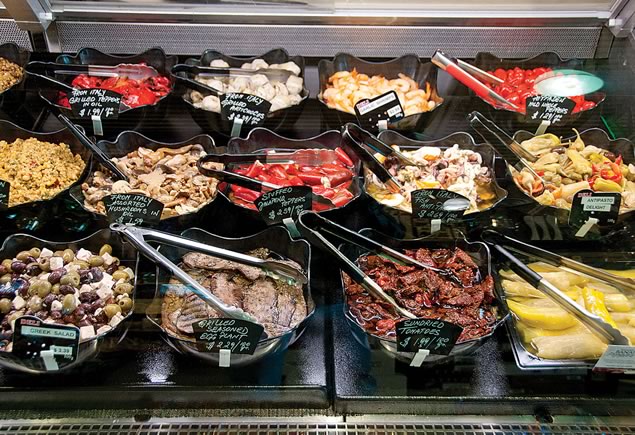
A Cook’s Tour of Bolton
May 18, 2012 | | Back IssuesHere, for the uninitiated, is Food In The Hills’ tour of Bolton’s gourmet highlights:

That’s Entertainment: Miriam Streiman’s Country Kitchen
Aug 17, 2012 | | Back IssuesMiriam Streiman’s country kitchen is more than a place to eat, drink and be merry – it’s a culinary stage and she’s the leading lady.
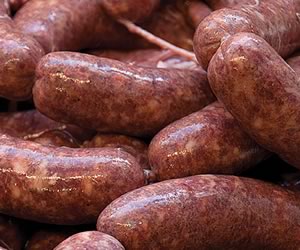
The Sausage King of Broadway Farm’s Market
Sep 9, 2011 | | Homegrown in the HillsSausages that are fast becoming a popular option, even among Broadway Farm’s Market’s most health-conscious customers.
Related Recipes
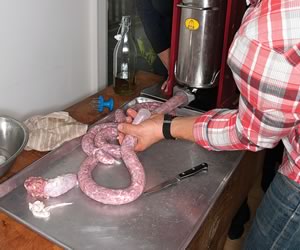
Homemade Pork Sausage
Mar 23, 2014 | | Back IssuesWith the right equipment and ingredients, a pinch of perseverance, and a big dollop of humour, you can make your own sausages.
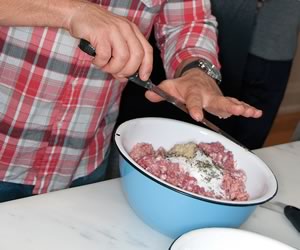
Mexican Chorizo
Mar 23, 2014 | | Back IssuesThere is something so “suggestive” about sausages, something elemental … No wonder they are often the subject of ribald, schoolyard-type humour.

